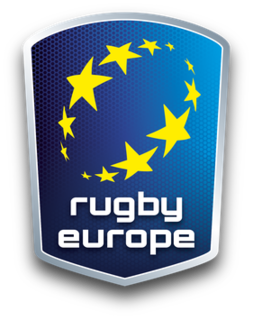The Rugby Europe International Championships is the European Championship for tier 2 and tier 3 rugby union nations.

The Armenian national rugby union team began playing in the European Nations Cup in 2004. However, Rugby Europe suspended the Rugby Federation of Armenia in November 2014 due to inactivity.

The Russia national rugby union team represents Russia in men's international rugby union international competitions, nicknamed the Bears, is administered by the Rugby Union of Russia (RUR). The RUR is considered the official successor union of the Soviet Union by World Rugby and the combined CIS team which played in the early 1990s. Since 1992, the team has played as Russia. Its first test match as Russia was against the Barbarians in Moscow in June 1992 and the country's first test against an official Test nation was against Belgium later that same year.

The Germany national rugby union team represents Germany in men's international competitions. currently plays at the second level of European rugby but is yet to qualify for the Rugby World Cup. The national team first played in 1927, with rugby union in Germany being administered by the German Rugby Federation.

The Lithuania national rugby union team represents Lithuania in men's international rugby union competitions. Nicknamed The Knights (Vytis), is considered one of the relatively stronger tier 3 teams in European rugby and currently compete in the second division of the Rugby Europe International Championships in the Rugby Europe Trophy, a competition which is just below the Rugby Europe Championship where the top 6 countries in Europe compete. They are yet to participate in any Rugby World Cup and play in black with a pattern involving the colours red, yellow and green.
The 2006–2008 European Nations Cup (ENC) Second Division will be contested over two years during which all teams meet each other home and away. The winner of Division 2A, Germany, will be promoted to Division 1 and fifth place, Netherlands, relegated to Division 2B. The winner, Poland, and loser of Division 2B shall be promoted to Division 2A and relegated to Division 3A, respectively.
With most of the senior nations preparing for the World Cup, FIRA organised a "Women ENC XV a side Tournament" for the six leading nations who were not in the Six Nations. While it does not appear to be part of the Women's European Championship sequence, it was very similar to the European Championship, especially the Pool B competitions.
The 2000 European Nations Cup was the first European Nations Cup, an international rugby union competition for second-tier nations. It replaced the FIRA Tournament following the emergence of professionalism in rugby union and Italy being granted a place in the Six Nations.
The 2008–10 European Nations Cup First Division was the 7th edition of the championship since it was reformed in 2000. The championship not only determined the champions of the ENC but it also acted as an element of European qualification for the 2011 Rugby World Cup in New Zealand.

Rugby union in Cyprus is a minor but growing sport.
Germany at the 2006–08 European Nations Cup was the first time since 1981 that the German national rugby union team reached highest level of FIRA rugby, the European Nations Cup, by winning its group, the Division 2A in 2006–08.

The 2010–12 European Nations Cup is the premier rugby union competition below the Six Nations Championship in Europe.
The 2012–14 European Nations Cup First Division is the premier rugby union competition below the Six Nations Championship in Europe. It is divided into two tiers; Division 1A and Division 1B.
The 2012–14 European Nations Cup Third Division is the fourth tier of rugby union in Europe behind the Six Nations Championship and the 2012-2014 European Nations Cup First Division and the 2012–14 European Nations Cup Second Division.
The 2012–14 European Nations Cup Second Division is the third tier rugby union in Europe behind the Six Nations Championship and the 2012-2014 European Nations Cup First Division.
The 2014–16 European Nations Cup First Division is the premier rugby union competition below the Six Nations Championship in Europe. It is divided into two tiers; Division 1A and Division 1B.

Rugby Europe is the administrative body for rugby union in Europe. It was formed in 1999 to promote, develop, organise and administer the game of rugby in Europe under the authority of World Rugby.
The 2014–16 European Nations Cup Second Division is the third tier rugby union in Europe behind the Six Nations Championship and the 2014–16 European Nations Cup First Division.

Rugby union in Montenegro is a minor but growing sport. The game has only recently been developed in the country since its independence in 2006. The governing body is the Montenegrin Rugby Union which was accepted as a member of Rugby Europe at the 2014 convention held in Split, Croatia. It is not yet affiliated with World Rugby but is applying for membership.
This page is based on this
Wikipedia article Text is available under the
CC BY-SA 4.0 license; additional terms may apply.
Images, videos and audio are available under their respective licenses.







